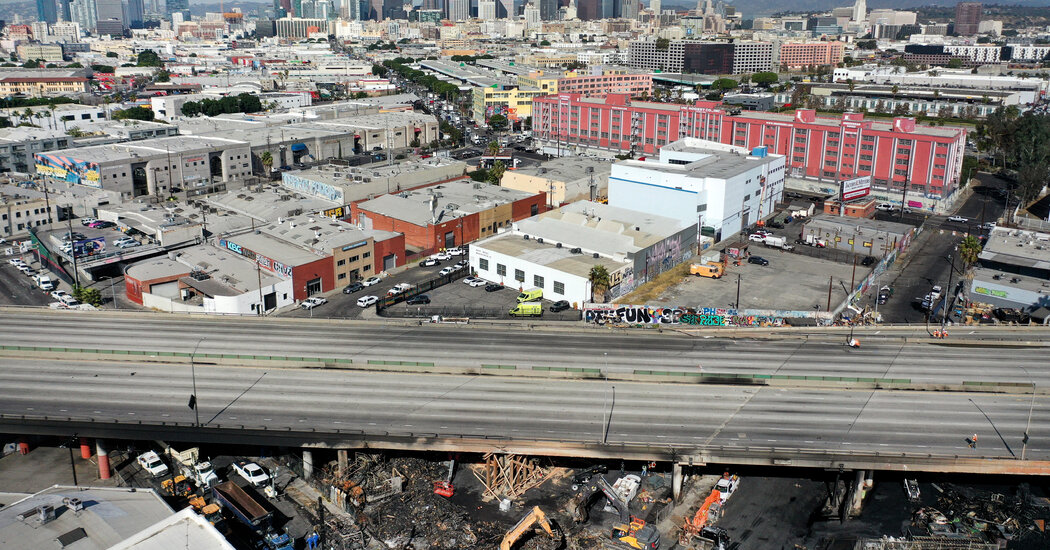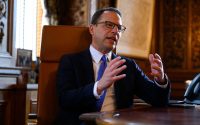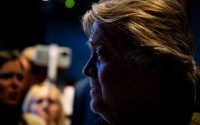California College Campuses Convulsed in Protest During Israel-Hamas War
Tensions have been especially high on university campuses since the war between Israel and Hamas began a month ago.
The police were called to a U.C. Davis student Senate meeting after students supporting Israel and Palestine began shouting at one another. Stanford Law School moved classes online for a day because of students’ concerns about their safety. On Friday, an Arab Muslim student at Stanford University was hurt in a hit-and-run crash that’s being investigated as a hate crime.
Some have compared the scale of campus protests to demonstrations against the Vietnam War in the 1960s, but there’s a key difference. This time, there are deeper divisions among students, as the conflict has widened a yawning gulf between those supporting Israel and Palestine.
Many students disagree about how to even talk about the violence, and feelings are heightened by grief as deaths continue to mount in the Middle East. Hamas’s surprise attack on Israel on Oct. 7 killed 1,400 people, and the Israeli government has since unleashed a devastating barrage of airstrikes against Hamas in the Gaza Strip, where health officials say more than 10,000 people are now dead. You can follow the latest Times coverage of the war here.
At U.C. Berkeley, a campus famous for its political activism, students on both sides have reported that they’ve been threatened and doxxed. Many wear masks to protests for fear of being identified and harassed on social media.
The debate has been polarizing. A Berkeley law professor wrote an opinion essay in The Wall Street Journal calling for firms not to hire his “antisemitic law students.” A group of 300 U.C. faculty members, including many at U.C. Berkeley, wrote a letter condemning the university system’s use of the word “terrorism” to describe Hamas’s attacks on Israel.
After a conflict on U.C. Berkeley’s Sproul Plaza between Jewish students and students opposed to Israel’s actions, in which a campus rabbi even took a few blows, Ron Hassner, a professor of Israel studies, had an idea to try to encourage peace at the university. He emailed Hatem Bazian, a lecturer in Middle Eastern languages and cultures and Asian American and Asian diaspora studies, to ask if he would want to co-write a statement calling for students to treat one another with dignity and respect.
The two men teach in the same building and are cordial to each other, but they disagree vehemently on Israel and Palestine. They share no common ground — and that was exactly the point of coming together to collaborate, they told me.
U.C. Berkeley’s chancellor, Carol Christ, emailed their joint statement to the student body. It reads, in part: “We will not tolerate our students harming one another. Disagreement and differing points of view are an essential part of campus life, and we expect that you treat one another with the same respect and dignity that we are modeling here.”
The statement is spare, in part because there is so little the men agree on, including the language to characterize the violence in the Middle East. When I contacted them about a joint phone interview last week, they each said they preferred to speak separately with me.
“The wounds are open, and we are grieving,” Hassner told me by email. “The significance of the letter, in my mind, is not that we are friendly colleagues who joined forces for peace but rather that we are not. Writing that letter together was very hard for both of us.”
Bazian told me that their statement wasn’t meant to change people’s minds about the conflict, but to dissuade students from resorting to violence. “With the type of intensity of what is taking place in Gaza, I think the temperature of the campus is at a high critical level,” he said. “We want to make sure that everyone has the space to express themselves without actually crossing any boundaries that they would regret.”
Hassner said he was clinging to the statement as a sliver of optimism in a dark time. He said he had been moved to tears when Bazian agreed to write it with him.
He told me: “It seemed to me like a moment of hope for academia — that there’s something that can be saved if two professors who disagree about everything can agree that academia is sacred. Then at least we’re standing on a solid foundation. And that gives me a lot of hope.”
Where we’re traveling
Today’s tip comes from Mary Ann Mitchell, who lives in Folsom. Mary Ann recommends her own town, 30 minutes northeast of Sacramento:
“There are so many things to love! We are surrounded by oak trees and water. The historic downtown is full of delicious and unique restaurants and wine tasting spots, along with shops and my favorite independent bookstore, Ruby’s Books. There are fun experiences everywhere. Folsom is also full of California gold rush history, and there are so many state parks nearby. The Folsom Powerhouse State Historic Park, Folsom Lake, Lake Natoma and Black Minors Bar are just next door. Having access to the water where folks swim, kayak, paddle board and boat is the best. There is so much to explore, yet my most favorite thing about my town is our bike trails. My husband and I try to ride often. We have miles and miles of trails that wind through the oak trees, pass by wooded creeks and streams, wander by wet lands full of birds, glide along old railroad tracks and run next to the American River, and you can usually find a coffee shop nearby for a break. It’s a wonderful way to escape a busy life. I love where I live and am so fortunate to have landed here in Folsom.”
Tell us about your favorite places to visit in California. Email your suggestions to [email protected]. We’ll be sharing more in upcoming editions of the newsletter.
Tell us
I’m thinking about how Californians celebrate Thanksgiving. By the beach? With sourdough stuffing?
Email your Golden State Thanksgiving traditions to [email protected]. Please include your full name and the city in which you live.
And before you go, some good news
When Claire Marie-Elisabeth Rabut met Aaron Gabriel Nastaskin, an exchange student at her high school in Chartres, France, he didn’t quite match the picture in her mind of a typical Californian. But he, a Los Angeles native studying in France, was smitten with her.
In the years that followed, the two lost touch, pursuing college degrees in their respective countries, though remaining friends on Facebook. But their paths crossed again in Paris almost eight years later, where, as fate would have it, Rabut was studying and Nastaskin was interviewing for a job. On a whim, Nastaskin suggested they meet to catch up, and there, on a snowy day in Paris over lunch at a Vietnamese restaurant, the two hit it off, flakes falling softly on the street behind them.
A few late nights and a weekend getaway later, it was love. Nastaskin moved back to Los Angeles a little while later to start a food marketing company, and Rabut joined him soon after finishing her Ph.D., taking a job as a postdoctoral research scholar in biomedical engineering at Caltech.
When the couple became engaged in April 2022, they commenced a season of wedding festivities that honored their shared multicultural backgrounds (Rabut is French and Vietnamese, and Nastaskin has family from Kyiv), as well as their international love affair — from Chartres City Hall all the way to their temple in Redondo Beach.
Thanks for reading. I’ll be back tomorrow. — Soumya
P.S. Here’s today’s Mini Crossword.
Maia Coleman and Briana Scalia contributed to California Today. You can reach the team at [email protected].
Sign up here to get this newsletter in your inbox.


